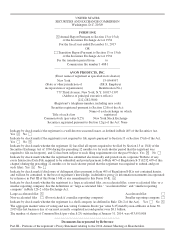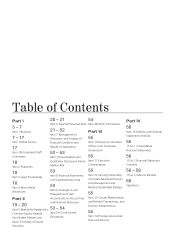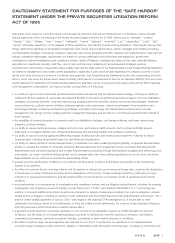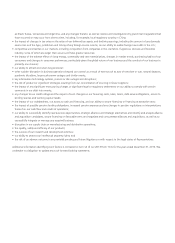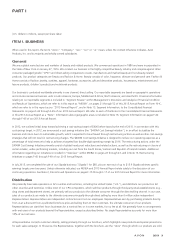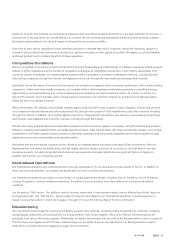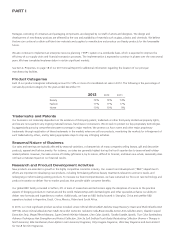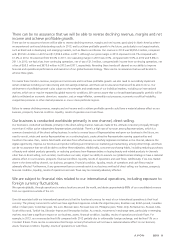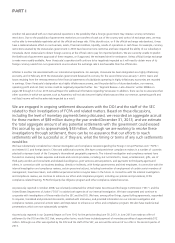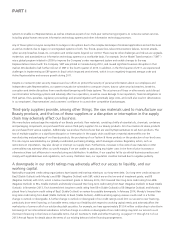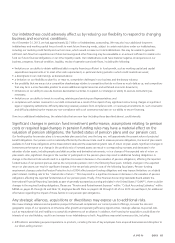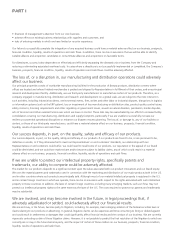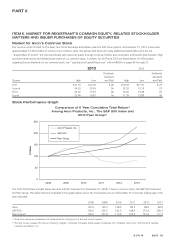Avon 2013 Annual Report Download - page 17
Download and view the complete annual report
Please find page 17 of the 2013 Avon annual report below. You can navigate through the pages in the report by either clicking on the pages listed below, or by using the keyword search tool below to find specific information within the annual report.There can be no assurance that we will be able to reverse declining revenue, margins and net
income and achieve profitable growth.
There can be no assurance that we will be able to reverse declining revenue, margins and net income, particularly in North America where
we experienced continued deteriorating results in 2013, and to achieve profitable growth in the future, particularly in our largest markets,
such as Brazil and in developing and emerging markets, such as Mexico and Russia. Our revenue in 2013 was $9,955.0 million, compared
with $10,561.4 million in 2012 and $11,099.5 million in 2011. Although our gross margin in 2013 improved to 62.1% compared with
61.2% in 2012, this declined from 63.4% in 2011. Our operating margin in 2013 was 4.3%, compared with 5.0% in 2012 and 9.8% in
2011. In 2013, we had a loss from continuing operations, net of tax of $1.0 million, compared with income from continuing operations, net
of tax of $93.3 million and $675.6 million in 2012 and 2011, respectively. Reversing these trends will depend on our ability to improve
financial and operational performance and execution of our global business strategy. There can be no assurance that we will be able to
achieve these goals.
To reverse these trends in revenue, margins and net income and to achieve profitable growth, we also need to successfully implement
certain initiatives including our restructuring and cost-savings initiatives, and there can no assurance that we will be able to do so. Our
achievement of profitable growth is also subject to the strengths and weaknesses of our individual markets, including our international
markets, which are or may be impacted by global economic conditions. We cannot assure that our broad-based geographic portfolio will be
able to withstand an economic downturn, recession, cost or wage inflation, commodity cost pressures, economic or political instability,
competitive pressures or other market pressures in one or more particular regions.
Failure to reverse declining revenue, margins and net income and to achieve profitable growth could have a material adverse effect on our
business, prospects, financial condition, liquidity, results of operations and cash flows.
Our business is conducted worldwide primarily in one channel, direct selling.
Our business is conducted worldwide, primarily in the direct-selling channel. Sales are made to the ultimate consumer principally through
more than 6 million active independent Representatives worldwide. There is a high rate of turnover among Representatives, which is a
common characteristic of the direct selling business. In order to reverse losses of Representatives and grow our business in the future, we
need to recruit, retain and service Representatives on a continuing basis, create attractive Representative earning opportunities and
transform the value chain, restore field health and sales force effectiveness, successfully implement initiatives in the channel, advance the
digital opportunity, improve our brochure and product offerings and improve our marketing and advertising, among other things, and there
can be no assurance that we will be able to achieve these objectives. Additionally, consumer purchasing habits, including reducing purchases
of beauty and related products generally, or reducing purchases from Representatives or buying beauty and related products in channels
other than in direct selling, such as retail, could reduce our sales, impact our ability to execute our global business strategy or have a material
adverse effect on our business, prospects, financial condition, liquidity, results of operations and cash flows. Additionally, if we lose market
share in the direct-selling channel, our business, prospects, financial condition, liquidity, results of operations and cash flows may be
adversely affected. Furthermore, if any government bans or severely restricts our business method of direct selling, our business, prospects,
financial condition, liquidity, results of operations and cash flows may be materially adversely affected.
We are subject to financial risks related to our international operations, including exposure to
foreign currency fluctuations.
We operate globally, through operations in various locations around the world, and derive approximately 88% of our consolidated revenue
from our operations outside of the U.S.
One risk associated with our international operations is that the functional currency for most of our international operations is their local
currency. The primary currencies for which we have significant exposures include the Argentine peso, Brazilian real, British pound, Canadian
dollar, Chilean peso, Colombian peso, the euro, Mexican peso, Peruvian new sol, Philippine peso, Polish zloty, Romanian leu, Russian ruble,
South Africa rand, Turkish lira, Ukranian hryvna and Venezuelan bolívar. As a result, movements in exchange rates, particularly in emerging
markets, may have a significant impact on our business, assets, financial condition, liquidity, results of operations and cash flows. For
example, in 2013, our revenues declined 6% compared with 2012 partially due to unfavorable foreign exchange, and declined 1% on a
Constant $ basis. There can be no assurance that foreign currency fluctuations will not have a material adverse effect on our business,
assets, financial condition, liquidity, results of operations or cash flows.
A V O N 2013 9


